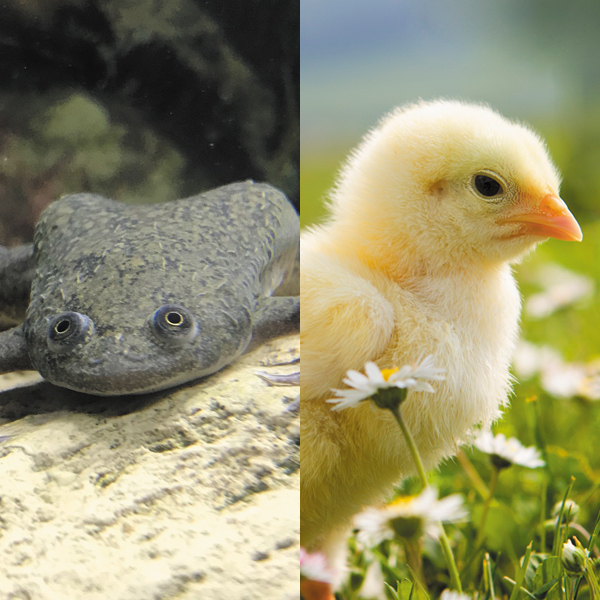Mar. 28, 2024 Research Highlight Biology
Comparing how limbs develop in chicks and frogs
A new coordinate system allows researchers to directly compare limb development between species

Figure 1: Despite their differences, frogs and chicks show similar tissue morphogenetic patterns in the development of their limbs. © Holly Mahaffey Photography/Moment/Getty and © Westend61/Getty
To shed light on the principles that govern tissue dynamics across species, RIKEN biologists have developed a new method for analyzing the development of vertebrate limbs1. These principles could help guide the development of artificial organs known as organoids.
In 1917, in his landmark book On Growth and Form, Scottish biologist Sir D’Arcy Wentworth Thompson showed that differences in animal shape among closely related species can be described by simple geometric transformations, suggesting the presence of a standard shape underlying them. Yet, more than a century later, very little is known about the mathematical principles that shape the body and body parts of different species during development.
By building on previous studies that investigated the development of chick limbs, Yoshihiro Morishita of the RIKEN Center for Biosystems Dynamics Research and his colleagues have now sought to determine whether the patterns of change in tissues over space and time (i.e., physical morphogenetic processes) also share common dynamics across different species.
They proposed a space–time coordinate system that enables tissue dynamics to be compared directly across species that differ in size, shape and developmental time scale. Applying it to the early stages of limb development in chicks and frogs, the researchers found that tissue dynamics are well conserved between the two species, at least until skeletal patterns become established.
“The proposed coordinate system could reveal an organ-specific design principle that is independent of species, which will lead to a deeper understanding of developmental biology,” Morishita concludes.
By labeling and tracing cells in developing limb buds, the team was able to examine the patterns of tissue growth and deformation in space and time. They demonstrated that the patterns are so similar across species in the proposed coordinate system that they are difficult to distinguish.
The expression dynamics of some typical limb marker genes were also similar in the proposed coordinate system across the two species, suggesting that the development of vertebrate limbs is regulated by physical processes and signaling pathways that are well conserved across species in a quantitative manner.
“Our findings suggest the existence of archetypal dynamics across species when homologous organs with different sizes and shapes are formed,” says Morishita.
To determine just how universal the tissue dynamics are that are conserved between chickens and frogs, Morishita and his team now intend to apply the same methodology to other organs and in a range of species.
They also plan to compare the genome-wide patterns of gene expression in time and space across species to uncover genes that are likely to drive interspecies differences in organ morphology. Uncovering the essential design principles behind organ morphogenesis will contribute to manipulating organ morphology, including the generation of better organoids.
Related contents
- Simple but revolutionary modular organoids
- Mechanical sensors help coordinate cell organization during eye development
- Mechanical forces shape animal "origami" precisely despite "noise"
Rate this article
Reference
- 1. Morishita, Y., Lee, S.-W., Suzuki, T. Yokoyama, H., Kamei, Y., Tamura, K. & Kawasumi-Kita, A. An archetype and scaling of developmental tissue dynamics across species. Nature Communications 14, 8199 (2023). doi: 10.1038/s41467-023-43902-y
